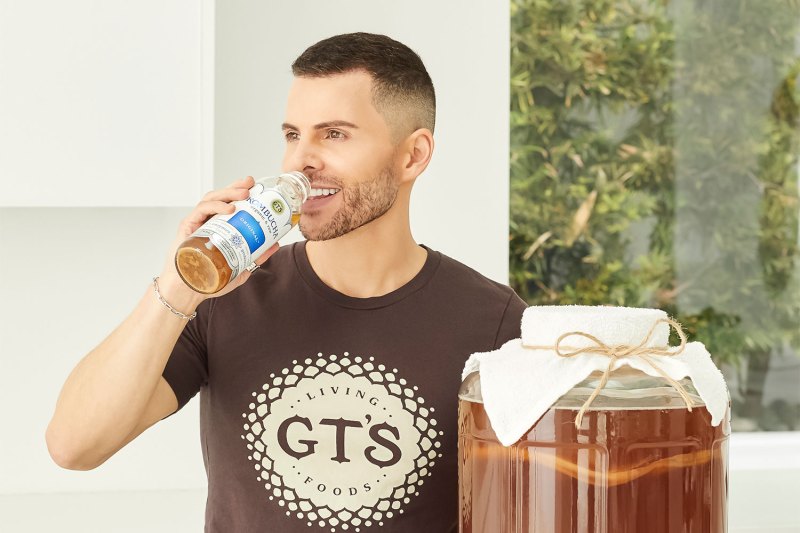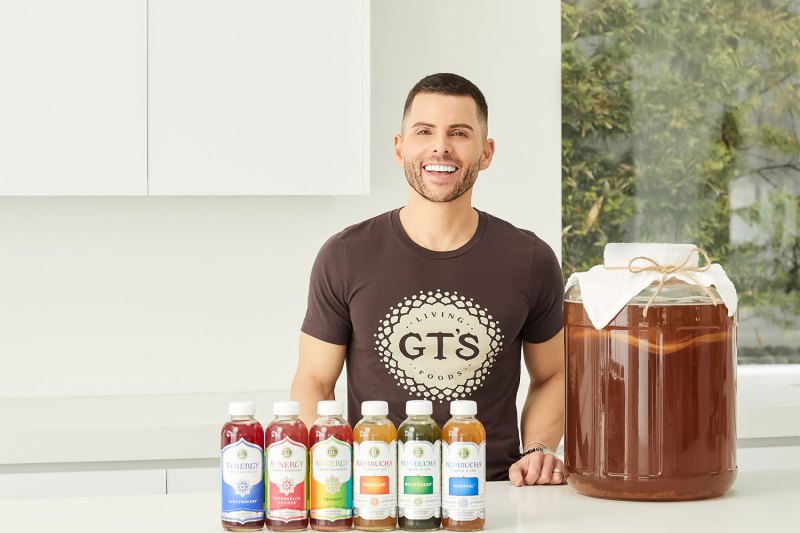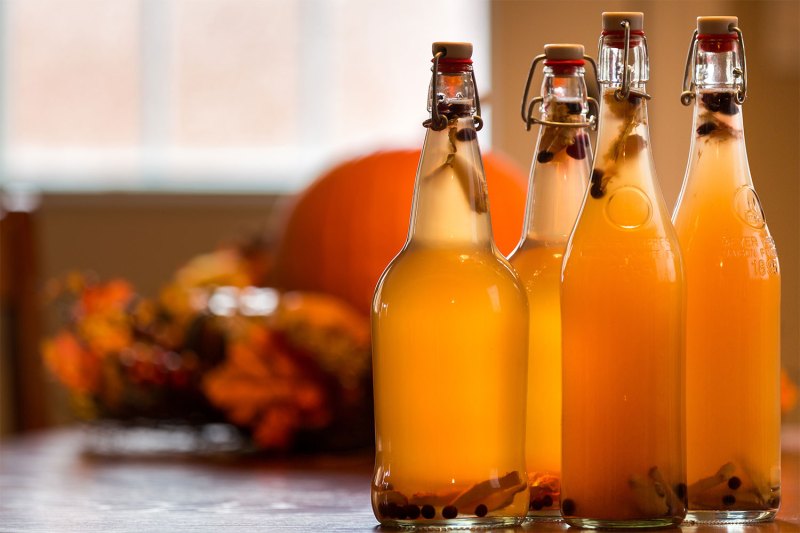Let me start by saying there’s no greater sourdough bread fan than me. And because I’m an out-and-proud sourdough snob, I have refused to join the internet in making my own sourdough bread during quarantine. Much as I’ve been admiring the world’s amateur baking efforts over the past several weeks, I have too much respect for the complex, intuitive art of bread-making to insult it with my halfhearted kitchen ethos.
If, like me, you’re attracted to the idea of a home fermentation project, but not ready to commit to the labor and attention required for sourdough baking, you’re the perfect candidate for brewing kombucha.
Forget whatever bougie associations you might have with kombucha. This drink is an artifact of ancient civilizations, offering a bounty of health benefits in the form of beneficial bacteria, along with a fizzy, pungent sweetness that offers the pick-me-up power of a cold brew, the thirst-quenching electrolyte boost of a vitamin water, and the tasty texture of an artisanal soda. Personally, I think there’s no better beverage to celebrate these final (we hope) weeks of quarantine.

Even if your area is slated to reopen for regular life in the coming days, it’s not too late to get that Quarantine DIY Project notch on your belt. To help make our case for making your own kombucha, we spoke with the leaders of some favorite kombucha brands, Greg Peters of San Diego’s JuneShine, Rachel Kanaan of Unity Vibration in Ypsilanti, and even the legendary G.T. Dave, whose kombucha started it all.
First, a primer. Kombucha is a fizzy fermented tea beverage with a surprisingly long history. The name is a Japanese portmanteau meaning “seaweed tea,” referring to the marine-life appearance of the slick beige culture (known as a SCOBY) that turns plain sweet tea into this life-lengthening, immune-boosting nectar. Primitive people of the forbidding Eurasian steppes are reported to have lived past 100 years old, thanks to kombucha. In the 1960s, kombucha brewing was a staple of back-to-the-earth households. But kombucha’s humble hippie reputation was turned inside out in the 2000s, when the organic food movement went mainstream. After being seen in the hands of Hollywood stars and health/fitness celebrities, it wasn’t long before kombucha had trickled down to the masses. Today, you can find kombucha sold in fine restaurants, cocktail bars, and chain coffee shops, in supermarkets and corner stores. I even encountered one gas station in Portland that sold kombucha on tap.
So why brew your own kombucha when it’s practically ubiquitous? Surprisingly, G.T. Dave, who sits on the biggest share of the kombucha market, makes a most eloquent case for it:
“Like anything you do on your own, brewing your own kombucha at home allows you to ensure that what you’re doing is as pure as possible.”
Dave says that many brands (he won’t name names) add additional steps to the minimalist process of making kombucha — hyper-filtering the liquid, pasteurizing it, adding carbonation to boost the fizz factor. They may be doing it in the spirit of trying to ensure stability, says Dave, but those extra steps undermine the kombucha’s gentle natural activity. By making it on your own, you can ensure that your batch is made from fresh, whole ingredients with maximum nutritional content, and that your fermentation has the time it needs to deliver the right potency. (I call this the “shudder factor,” that perfect burst of sour that makes the fizz and the sweetness that much more delicious.)

In addition, kombucha comes to the quarantine party with a bounty of health benefits. “We all know gut biome is everything,” says Unity Vibration’s Rachel Kanaan. “It rules our immune system, and kombucha can add healthy beneficial bacteria that balance and regulate the immune system.” JuneShine’s Greg Peters adds that even hard kombucha contains vitamins and antioxidants that have clinically proven health benefits, along with adding a lower-sugar, all-natural alternative to beer or booze.
Plus, says Kanaan, “Adding things like turmeric, ginger, reishi, and many other ingredients can work together with kombucha to create a kickass immune booster, while also imparting delicious and unique flavors.” Making your own kombucha allows you to customize the perfect blend of health benefits you’re looking for.
But Dave says there’s another good reason to brew your own kombucha at home. “It allows you to understand firsthand the beauty and the art, almost ceremony, involved in making these types of fermented foods. Growing a batch of kombucha is like growing a plant — it’s an opportunity to observe nature at its finest.”
In the mid-2000s, rumors floated around during a slow news cycle that home-brewed kombucha was dangerous. But after making and drinking home-brewed kombucha for the past 10 years, I can vouchsafe that making kombucha at home isn’t any more dangerous than cooking with chicken. Like just about any kitchen endeavor, a safe-to-consume result requires being clean, sanitary, and thoughtful.
Basic kombucha safety measures include:
- Washing your hands thoroughly before handling the SCOBY, the liquid, and the jar where it’s going to brew.
- Using a glass jar to brew kombucha. “You can’t use plastic, crystal, or aluminum,” cautions Dave. “The reason why is that the fermentation process can leach out impurities in those materials, and when it goes into the liquid, you end up ingesting those impurities.”
- Being careful about where the kombucha is left to brew. Too much light or heat can impair the fermentation process, while leaving it in a breezy place can introduce wild yeasts to the SCOBY. Leaving the jar mouth open and uncovered is an invitation to unwanted guests in your brew, such as dirt, other food matter, even bugs. And the last thing your SCOBY needs is a poke from a curious person’s finger or a pet’s nose or paw.
- Storing your kombucha in a sanitized jar or bottle. Once your kombucha is ready to drink, it’s imperative to use a well-sanitized vessel. To preserve the flavor and fizz, you’ll want to make sure it’s also air-tight, like a swing-top or screw-top bottle. (Avoid mason jars with metal lids, since the kombucha will react with the metal. A plastic lid is fine, as long as it’s not in direct contact with the liquid.)
“A lot of the mistakes I’ve witnessed come from people not doing their homework,” says Dave. “Brewing kombucha is more than a hobby — it’s almost like raising a child. It’s not a part-time thing. If you choose to embark on that journey, you make sure that you have the time, the space, and the patience to give this creation the necessary attention it deserves. When people don’t take time to understand, they make a bad batch, resulting in either giving up, or worse, drinking it and have an unpleasant reaction, and that becomes their most memorable experience of kombucha.”

While establishing your culture takes intention and effort, making your own kombucha quickly becomes routine. The simple steps are easy to fit into your week, and the whole endeavor can easily be paused, or delegated to someone else’s care, if you’re going to be away from home for a while. That’s what makes quarantine the perfect time to get started. After a week or two of practicing the steps, and savoring the rewards, you’ll find it no trouble incorporating your kombucha brewing project into your post-quarantine schedule.
Basic Kombucha Recipe
There are a million recipes out there, and they’re all more or less the same. This is the one that’s kept my SCOBY going strong for the past ten years.
What You’ll Need
- A gallon-size glass jar
- A thick paper towel or a few layers of cheesecloth to cover the mouth of the jar
- 1 cup of white sugar
- 6 tsp of caffeine-containing tea (black, green, oolong, pu-erh)
- 1 gallon of filtered spring water
- A SCOBY sourced elsewhere + 1/4 cup raw apple cider vinegar OR 1 bottle of your favorite kombucha
Method
- Combine the sugar, tea, and about 3 cups of filtered water in a medium-sized pot. Bring to a simmer and stir to make sure sugar is dissolved, then turn off heat and allow it to cool. (The tea will continue to brew as it’s cooling down.) This is your tea concentrate.
- Once tea concentrate is cool, add your SCOBY to the glass jar, pour in the vinegar, then add the concentrate on top. (It’s very important not to put hot liquid on top of your SCOBY, as this will kill the bacteria and yeast that will be fermenting the drink.) Fill the jar up with the remainder of the filtered water, leaving about an inch of room from the mouth of the jar.
- If you don’t have a SCOBY, you can grow one for yourself! In this version, add the full contents of a bottle of kombucha to the glass jar, then add in your tea concentrate and water the same as above. The fermentation process will just take a little longer the first time.
- Cover the mouth of the jar with a paper towel or cheesecloth, and secure with a rubber band. Leave your jar in a slightly warm (but not hot) part of the house with little direct light and no heavy moisture in the air, where no children or pets can reach it. Another factor to consider is temperature and humidity. “Temperature control is paramount when brewing at home,” says Peters. “Even a few degrees in either direction can create a stalled fermentation or undesirable off flavors.”
- Let the kombucha brew for about 14 days. It takes a little longer for the first batch to ferment, as the SCOBY is just now coming to life. Future batches might take only half as long, once your SCOBY is active.
- After at least 14 days (more is okay), ladle out a small amount of kombucha into a glass and taste it. “Good kombucha should be lightly fizzy, tart, and most importantly, drinkable,” says Peters. If what you taste is flat and sweet, your kombucha needs more time. Check again every 3 to 5 days until you taste a significant fizz and a green-apple bite. (You may see bubbles around the surface of your SCOBY — that’s another good sign that your kombucha is ready to harvest.)
- You can drink the kombucha now if you want to. Simply funnel into several smaller bottles or one big bottle, and store in the refrigerator. (Make sure to save about .25 cup of kombucha in the jar — it will act as an accelerant to the next batch you brew.)
- You can also do a secondary fermentation, which lets you build up more carbonation. It’s also a great time to introduce extra flavors.
- For a secondary fermentation, transfer your kombucha from the jar into a well-sanitized bottle (or several small bottles) with an air-tight lid. (Repurposed Grölsch beer bottles are ideal for this, but any swing-top or screw-top bottle will work.) If you like, you can add chunks of raw, peeled ginger, whole or ground spices, fresh or dried herbs, juice or crushed fruit/vegetables, or a separately made beer base if you want to make boozy kombucha. Add to taste, but be aware that a little goes a long way. Then seal bottles tightly and store in the same area where the kombucha was brewed — dark, not too hot, away from visitors. Let it sit about 5 to 7 days, then open (carefully) and enjoy.
What to Do If You Make a Mistake
Kombucha lets you know instantly if you’ve made a mistake: It tastes like vinegar, with very little sweetness. Letting fermentation go too far, says Kanaan, is the biggest mistake new brewers make. “Paying good attention and tasting the brew as you go can save a lot of time and hassle,” she says. “But if it gets too acidic, no need to throw away the SCOBY or give up. All you need to do is dump the batch and start over using the same SCOBY.”

It’s a little more serious when the SCOBY goes wrong, but it’s still very easy to recognize — you’ll see spots of colorful or fuzzy mold that let you know it’s been contaminated. (SCOBY mold looks very much like the mold you find on bread or fruit.) If this happens, you’ll need to throw out the entire SCOBY as well as the entire batch of kombucha. It sucks, but it’s better than drinking it and getting sick. Clean/sanitize your equipment and start over, and maybe try brewing in a different area of your home. (Learn more about how to prevent kombucha mold here.)
Advanced Kombucha Tips
Already a kombucha ninja? Here are some pro tips for how to upgrade your homebrew game.
Get crazy with flavors.
If you’ve had about as much ginger kombucha as you can stand, Kanaan recommends mixing things up with a trip to the farmers’ market. (Once things reopen, obviously.) “You’ll be using the absolute best produce, and the varied growing season forces inspiration and invention of flavors.” Until the farmers’ market is available, though, you can browse the offerings of your favorite kombucha brand, or even turn to your favorite restaurant or bar menu for inspiration. If there’s anything off-limits when it comes to flavoring kombucha, we haven’t heard about it yet.
Some of the most offbeat ingredients our experts have used include:
Unity Vibration: pawpaw, pea shoots, oak chips, shisho
GT’s: aronia berries, hops, tepache (fermented pineapple juice)
JuneShine: matcha tea, ancho chiles, activated charcoal (but be very careful when using activated charcoal in anything)
Get medicinal
Maximize the health benefits of your kombucha brew by adding some medicinal herbs or supplements to the secondary fermentation. Maca root, ashwaghanda, gingko bilboa, reishi or cordyceps extract, milk thistle … basically, if you can find it in a natural foods supplement shelf, it’s fine to add to your kombucha. (Just make sure to add no more than the recommended dose in each serving.) Many of these medicinal plants come with a strong taste, so finding a way to balance them with other flavors is a challenge worthy of a mixology master. For example, GT’s Kombucha currently has a special edition kombucha that pairs spirulina with coconut water and ginger for an extra refreshing chlorophyll boost with a beautiful blue color.
Try making boozy kombucha, i.e., kombucha beer
All of our experts wanted to be very clear that kombucha beer is a different animal from kombucha tea. You’ll want to read up on the best way to create an additional ferment, such as the beer base Unity Vibration makes with brewing yeast, or a fermented juice like the tepache GT’s kombucha uses. In general, Peters advises that “being extremely accurate with your sugar and yeast amounts will produce a predictable alcohol content and a healthy fermentation.” A fermented base of about 10 percent ABV will pair with the 1 to 3% ABV kombucha already contains, resulting in a boozy kombucha of about 5 to 8%.
Become a kombucha mixologist
If the “kombucha beer” project feels too involved, you can still have fun with boozy kombucha. Kombucha pairs wonderfully in a cocktail with tequila, aquavit, or other mild-flavored or botanical spirits. Kanaan recommends trying to re-create the flavor of your favorite tipple — for example, a ginger-infused kombucha with vodka, lime juice, and a dash of bitters makes a great twist on a Moscow Mule. And G.T. Dave says there’s anecdotal evidence of an additional benefit to the kombucha cocktail: “I hear that you don’t really get a hangover when you use kombucha as a mixer.”



